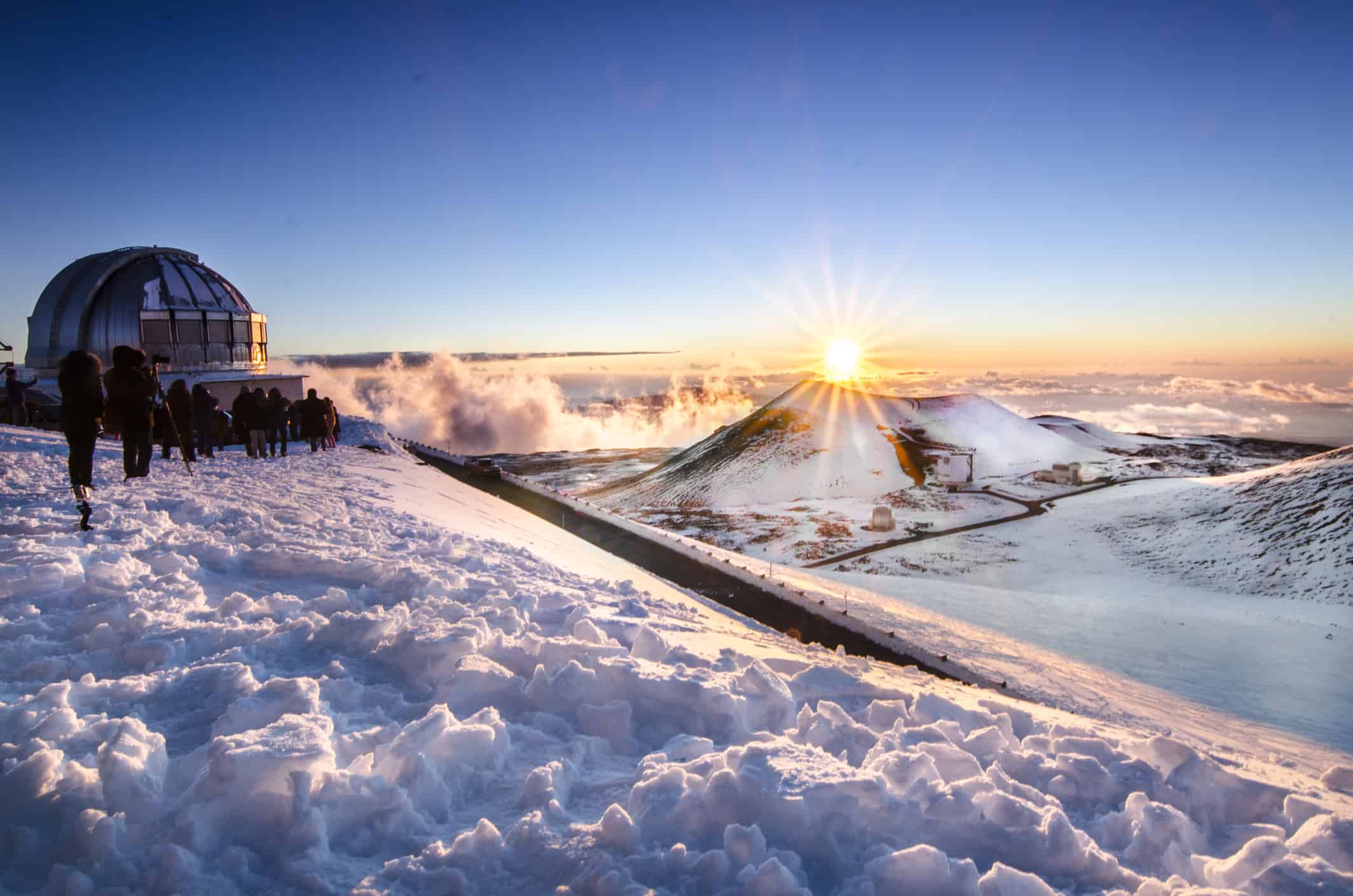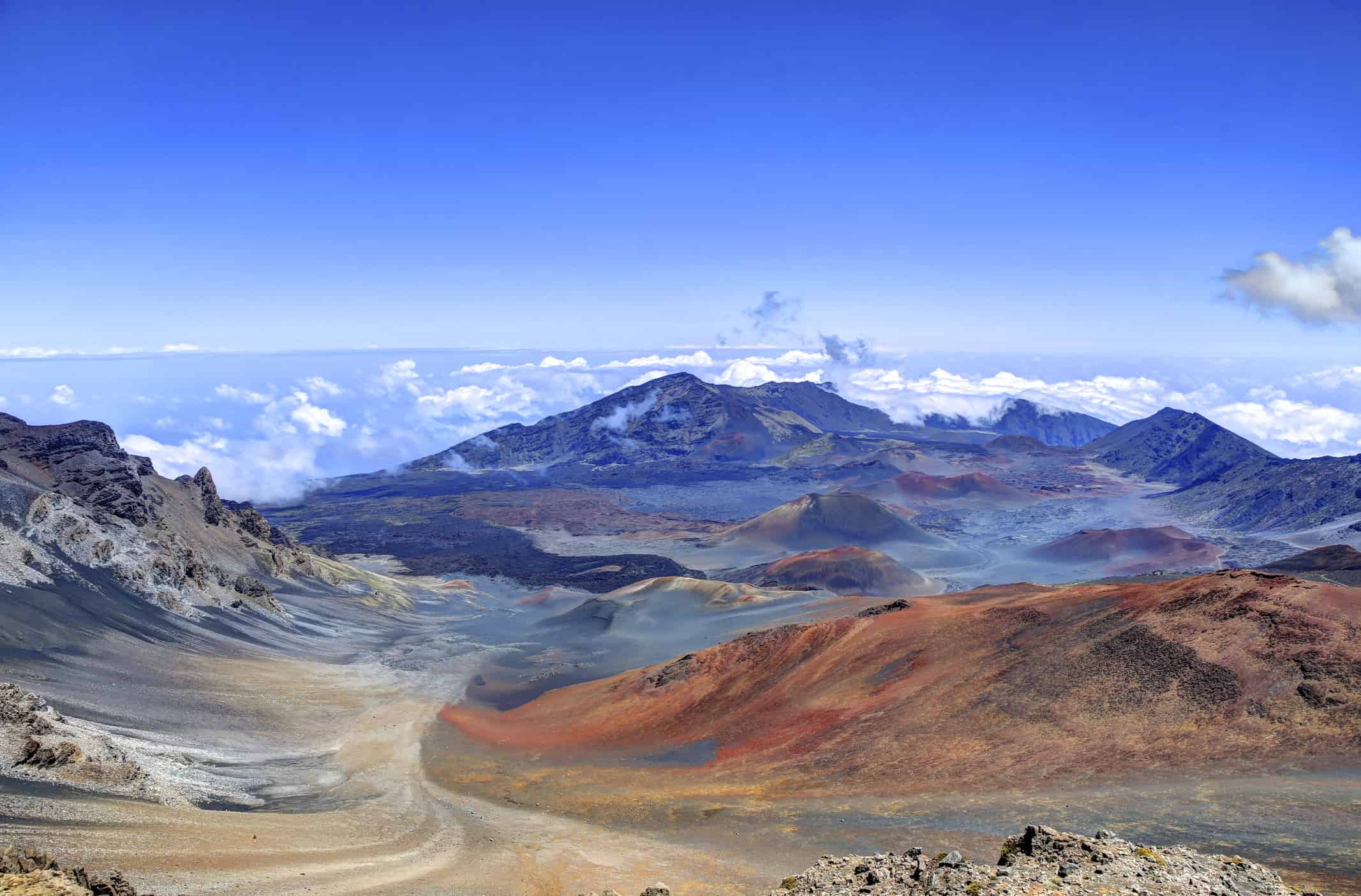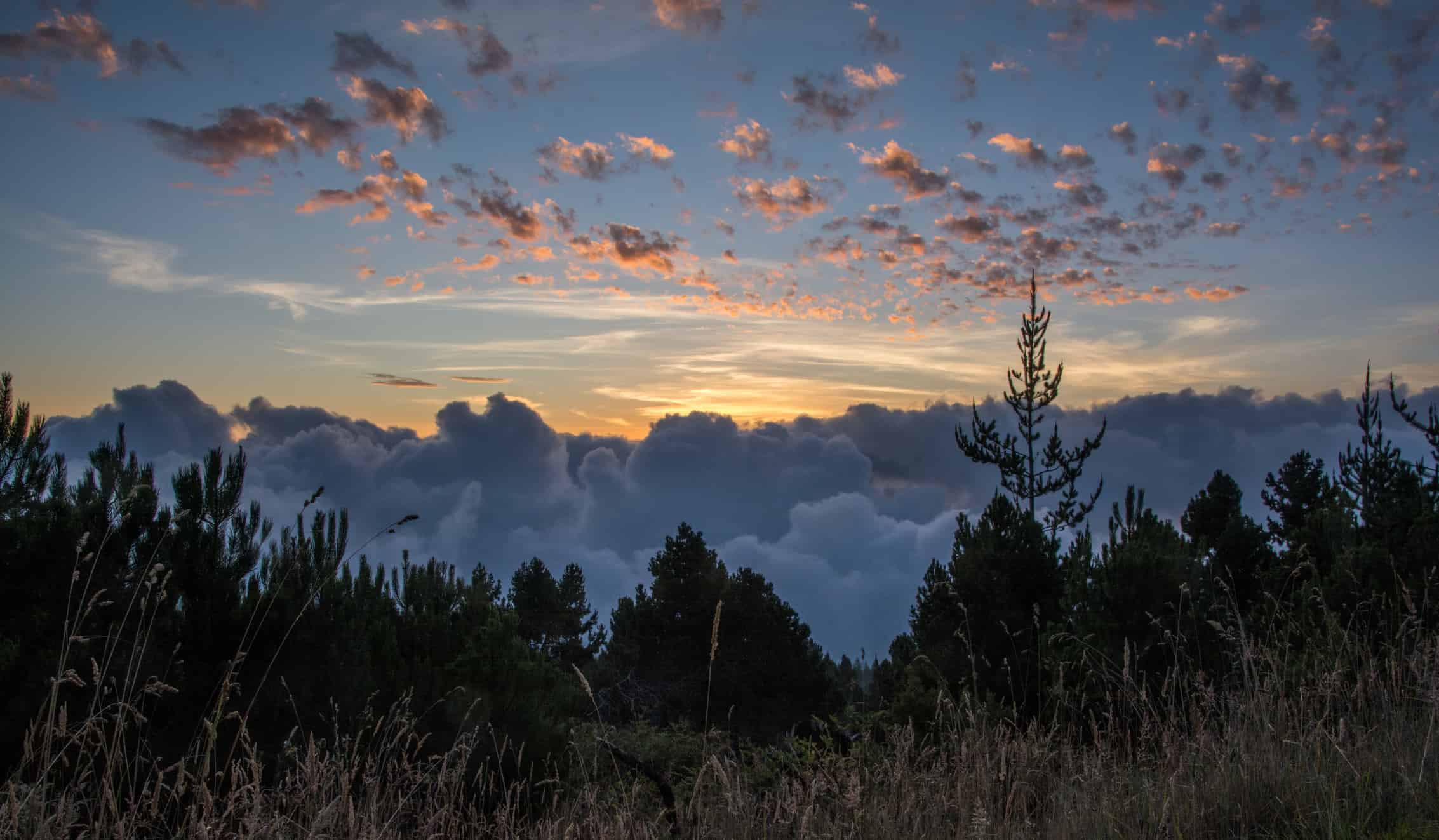As the only U.S. state located outside of North America, the archipelago, or group of islands known as Hawaii, is notorious for its tropical climate. Countless people live in and visit the state of Hawaii every year, taking advantage of its predominately hot weather. Even those who have never been to Hawaii most certainly picture palm trees, sandy beaches, the Pacific Ocean, volcanoes, and many other features that are not entirely synonymous with cold weather when they think of the state. However, the massively popular vacation spot is also surprisingly frosty in some spots. These are the five coldest places in Hawaii.
The Summit of Mauna Kea

Snow caps the peak of Mauna Kea, Big Island, Hawaii — the coldest place in the state.
©Ben Harding/iStock via Getty Images
Mauna Kea is a dormant volcano located on the Big Island, and at its peak, it holds the highest elevation in the state. However, it is not its impressive height that sets Mauna Kea apart from the rest of Hawaii but its shockingly frigid temperatures. During the winter months, average temps can quickly drop below freezing here. At the summit, temperatures are not infrequently falling as low as 10°F (-12°C).
The reason Mauna Kea gets so cold is an amalgamation of multiple factors. These elements include the extremely high altitude, high winds, and a lack of moisture in the atmosphere. The unique rudiments at Mauna Kea’s peak contribute to snowfall and icy formations, ultimately resulting in remarkable beauty. Still, this magnificence is tethered to biting cold temperatures. In fact, those who visit Mauna Kea are cautioned to bring warm clothing to fight against the chilly air!
On the summit of Mauna Kea, the mean annual air temperature (MAAT) is slightly above freezing at 39.2°F (4°C). The most frigid spots are located inside two distinct high-altitude craters where sporadic permafrost is found beneath their north-facing interior slopes. While the peak offers otherworldly views of the Pacific Ocean, surrounding islands, and lush green forests that are genuinely awe-inspiring, visitors should remember that it is the coldest place in Hawaii.
Haleakala Crater (Second Coldest Place in Hawaii)

Views of the Haleakala volcano crater on the Hawaiian island of Maui are breathtaking!
©todamo/iStock via Getty Images
Similar to Mauna Kea, Haleakala Crater is located on a majestic volcano. However, Haleakala Crater is on the Island of Maui and the second coldest place in the state on average. The crater is set 10,000 feet above sea level, and the climate changes dramatically the higher you go. Unfortunately, the air also becomes much thinner, resulting in breathing difficulties, as one might expect. The mixture of the surrounding ocean and high elevation forms a microclimate in the crater, adding frigid temperatures to the harshness of the environment.
During the winter months, average temperatures at Haleakala Crater can drop well below freezing, much like Mauna Kea. In fact, record-low temperatures are nearly identical to the extreme lows at the Summit of Mauna Kea, with a temperature of 10.4°F (-12°C). It is relatively common to find frost or snow at Haleakala Crater from time to time. However, the crater acts like a barrier that blocks high winds from reaching the interior. This results in much less precipitation and, therefore, much less rainfall than other places around Hawaii.
Again, the extraordinarily cold temperatures at Haleakala Crater are nothing to take lightly. All who plan to visit the area are cautioned to dress warm. While this feels obvious, many people are caught off guard by the freezing air due to the fact they are in Hawaii. They expect tropical weather on every nook and cranny around each Island. This is common; just don’t expect warmth in every crater!
Polipoli Spring State Park

The sun sets over PoliPoli Spring State Park on Maui, Hawaii.
©Kyle Kempf/iStock via Getty Images
Polipoli Spring State Recreation Area is located on the Island of Maui and is well-known for its cooler temperatures. However, this is the first place on this list that does not dip below freezing. The area is situated approximately 6,200 feet above sea level and filled with lush greenery. Since much of the Island of Maui offers plenty of heat and humidity, Polipoli Spring State Recreation Area is thought to be a respite of sorts for many. Unlike Mauna Kea and Haleakala Crater, this stays above 32°F (0°C) with an average temperature of 50°F (10°C).
The exquisite area covers around 10 acres of the Kula Forest Reserve, which spans approximately 21,000 acres. Due to its elevation, the area extends through what is known as the fog belt of the mountain forests. Many have said that entering the area feels nearly akin to stepping into another world, separate from the rest of Hawaii. This feeling is due to the towering trees and misty landscape. Of course, this is also due to the fact that Polipoli Spring State Recreation Area is one of the coldest places in Hawaii.
Waimea (The Big Island)

The town of Waimea, Kauai, with cultivated landscape, sits below storm clouds.
©eyebex/iStock via Getty Images
The Big Island is, on average, the coldest Island, making up the state of Hawaii. This is partially due to the average low temperatures at the peak of Mauna Kea. However, this is also partially due to the average temperature of Waimea, also known as Kamuela. Waimea is a town that sits at a high elevation (2,670 feet above sea level) and, despite being located in the tropics, experiences some of the chilliest temperatures in the state. Waimea sees an average annual temperature of 65°F (18°C).
Positioned in the hills of Kohala Mountains, Waimea spans 39.38 square miles of land. As of the 2020 census, the small town has a population of 7,028. The name of the town (Waimea) translates to reddish water, and was once a ranching community. Locals who wish to acknowledge the Hawaiian cowboys who once roamed the land often refer to the town as “Paniolo Country.” Waimea rests at a transition point between the dry and wet sides of the Big Island. This frequently results in drastic climate changes within spans as short as one mile.
Hana, Maui

Travelers take the scenic Hana Highway along the east coast of Maui to reach the town of Hana.
©Julie Caron/iStock via Getty Images
Situated on the eastern coast of Maui, the small town of Hana is the warmest location on this list. However, that does not mean that it’s not still pretty chilly for Hawaii. The town of Hana is entirely surrounded by thick green rainforests and bordered by steep cliffs. Its location creates a very unique microclimate of its own, which is much cooler than the vast majority of Maui. On average, the temperature in Hana sits at around 70°F (21°C). Like Waimea on the Big Island, Hana offers many people a perfect respite from the often sweltering heat of the lowlands.
At only 128 feet above sea level, the town’s elevation does not contribute to its slightly cooler climate. Rather, its location — surrounded by forest, waterfalls, and beaches — keeps it at a somewhat lower temperature than other parts of the Island. However, knowing that this lower temperature is not always that low is essential. Although the mean daily average temperature hovers around 70°F (21°C), record high temps have been as high as 91°F (33°C) in January and 94°F (34°C) in November. Still, its average makes it one of the coldest places in Hawaii!
Hana spans 10.56 square miles of land and has a general tropical rainforest climate. The small town’s population was 1,526 as of the 2020 census, and is primarily reached via the Hana Highway. This roadway is famous for how it winds through brilliant landscapes, black sand beaches, and jaw-dropping views of nearby waterfalls. While generally gorgeous and awe-inspiring, remember to bring at least a light jacket if you’re visiting, as the cooler temperatures often move in quickly and without warning.
Summary of the Coldest Places in Hawaii
| Location in Hawaii | Average Annual Temperature | |
|---|---|---|
| 1 | The Summit of Mauna Kea | 10°F (-12°C) |
| 2 | Haleakala Crater | 10.4°F (-12°C) |
| 3 | Polipoli Spring State Park | 50°F (10°C) |
| 4 | Waimea (The Big Island) | 65°F (18°C) |
| 5 | Hana, Maui | 70°F (21°C) |
Thank you for reading! Have some feedback for us? Contact the AZ Animals editorial team.








